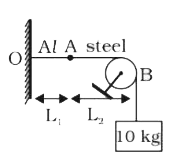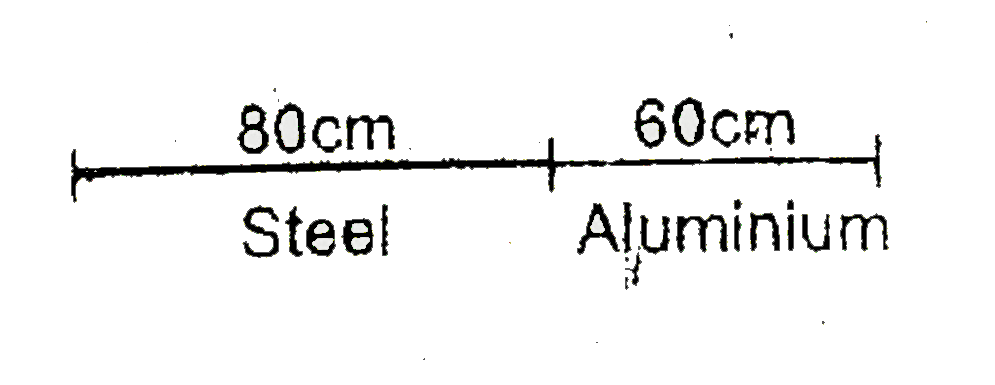An aluminium wire of cross-sectional area (10−6)m2 is joined to a steel wire of the same cross-sectional area. This compound wire is stretched on a sonometer pulled by a weight of 10kg. The total length of the compound wire between the bridges is 1.5m of which the aluminium wire is 0.6m and the rest is steel wire. Transverse vibrations are setup in the wire by using an external source of variable frequency. Find the lowest frequency of excitation for which the standing waves are formed such that the joint in the wire is a node. What is the total number of nodes at this frequency? The density of aluminium is 2.6×(103)kg/m3 and that of steel is 1.04×104kg/m2(g=10m/s2)
The correct Answer is:A, B, C, D
To solve the problem step by step, we need to find the lowest frequency of excitation for which standing waves are formed such that the joint in the wire is a node. We will also determine the total number of nodes at this frequency.
Step 1: Determine the Lengths of the Wires
The total length of the compound wire is given as 1.5 m. The length of the aluminium wire is 0.6 m. Therefore, the length of the steel wire (LS) can be calculated as:
LS=1.5m−0.6m=0.9m
Step 2: Calculate the Linear Mass Densities
The linear mass density (μ) of a wire is given by the formula:
μ=masslength=ρ⋅AL
where:
- ρ is the density of the material,
- A is the cross-sectional area,
- L is the length of the wire.
For aluminium:
- Density ρA=2.6×103kg/m3
- Cross-sectional area A=10−6m2
- Length LA=0.6m
Calculating the linear mass density for aluminium:
μA=2.6×103kg/m3×10−6m20.6m=2.6×10−30.6≈4.33×10−3kg/m
For steel:
- Density ρS=1.04×104kg/m3
- Length LS=0.9m
Calculating the linear mass density for steel:
μS=1.04×104kg/m3×10−6m20.9m=1.04×10−20.9≈1.16×10−2kg/m
Step 3: Establish the Relationship Between Frequencies
The frequency of the waves in each wire can be expressed as:
fA=nAvA2LAandfS=nSvS2LS
where nA and nS are the number of loops in aluminium and steel respectively, and vA and vS are the wave velocities in aluminium and steel.
Since both wires vibrate at the same frequency:
fA=fS
Step 4: Calculate the Wave Velocities
The wave velocity in a wire is given by:
v=√Tμ
where T is the tension in the wire. The tension due to the weight of 10 kg is:
T=mg=10kg×10m/s2=100N
Calculating the velocities:
vA=√100N4.33×10−3kg/m≈148.5m/s
vS=√100N1.16×10−2kg/m≈91.5m/s
Step 5: Set Up the Equation for Frequencies
From the frequency equations:
nAvA2LA=nSvS2LS
This simplifies to:
nAnS=vSLAvALS
Step 6: Substitute Values
Substituting the known values:
nAnS=91.5×0.6148.5×0.9≈54.9133.65≈0.41
This ratio suggests that the lowest integer values for nA and nS that satisfy this ratio are nA=1 and nS=3.
Step 7: Calculate the Minimum Frequency
Using the frequency formula for aluminium:
fmin=nAvA2LA=1×148.52×0.6≈123.75Hz
Step 8: Determine the Total Number of Nodes
The total number of nodes in the system can be calculated as:
- For nA=1: 2 nodes (1 at each end)
- For nS=3: 4 nodes (3 loops create 4 nodes)
Thus, the total number of nodes:
Total Nodes=2+4−1=5
Final Answers
- The lowest frequency of excitation is approximately 123.75 Hz.
- The total number of nodes at this frequency is 5.
The total length of the compound wire is given as 1.5 m. The length of the aluminium wire is 0.6 m. Therefore, the length of the steel wire (LS) can be calculated as:
LS=1.5m−0.6m=0.9m
The linear mass density (μ) of a wire is given by the formula:
μ=masslength=ρ⋅AL
where:
- ρ is the density of the material,
- A is the cross-sectional area,
- L is the length of the wire.
- Density ρA=2.6×103kg/m3
- Cross-sectional area A=10−6m2
- Length LA=0.6m
μA=2.6×103kg/m3×10−6m20.6m=2.6×10−30.6≈4.33×10−3kg/m
- Density ρS=1.04×104kg/m3
- Length LS=0.9m
μS=1.04×104kg/m3×10−6m20.9m=1.04×10−20.9≈1.16×10−2kg/m
The frequency of the waves in each wire can be expressed as:
fA=nAvA2LAandfS=nSvS2LS
where nA and nS are the number of loops in aluminium and steel respectively, and vA and vS are the wave velocities in aluminium and steel.
fA=fS
The wave velocity in a wire is given by:
v=√Tμ
where T is the tension in the wire. The tension due to the weight of 10 kg is:
T=mg=10kg×10m/s2=100N
vA=√100N4.33×10−3kg/m≈148.5m/s
vS=√100N1.16×10−2kg/m≈91.5m/s
From the frequency equations:
nAvA2LA=nSvS2LS
This simplifies to:
nAnS=vSLAvALS
Substituting the known values:
nAnS=91.5×0.6148.5×0.9≈54.9133.65≈0.41
This ratio suggests that the lowest integer values for nA and nS that satisfy this ratio are nA=1 and nS=3.
Using the frequency formula for aluminium:
fmin=nAvA2LA=1×148.52×0.6≈123.75Hz
The total number of nodes in the system can be calculated as:
- For nA=1: 2 nodes (1 at each end)
- For nS=3: 4 nodes (3 loops create 4 nodes)
Total Nodes=2+4−1=5
- The lowest frequency of excitation is approximately 123.75 Hz.
- The total number of nodes at this frequency is 5.
Similar Questions
A wire of cross-sectional area A breaks due to its own weight when length of the wire is l. If area of cross-section of the wire is made 3A then maximum length of the wire can be hung without breaking is
View SolutionAn aluminium wire and a steel wire of same cross-sectional of 10−2cm2 were connected together. A 10 kg block loaded on the compound wire as shown in figure. Waves are set up in the compound wire. The minimum frequency of excitation for which standing waves are observed with point A as a node is [L1=60cm,L2=86.6cm] density of aluminium =2.6g/cm3 and of steel=7.8g/cm3]
 View Solution
View Solution
Knowledge Check
- Question 1 - Select One
A wire of length L and cross-sectional area A is made of a material of Young's modulus Y. IF the wire is stretched by an amount x, the workdone is
AYAx22LBYAx2L2CYAx2LDYAx2L - Question 2 - Select One
A wire of length L and area of cross-section A, is stretched by a load. The elongation produced in the wire is I. If Y is the Young's modulus of the material of the wire, then the force constant of the wire is
AYLABYlACYALDYAl
Figure shows an aluminium wire of length 60cm joined to a steel wire of length 80cm and stretched between two fixed supports. The tension produced is 40N. The cross-sectional area of the steel wire is 1.0mm2 and that of the aluminimum wire is 3.0mm2 The minimum frequency of a tuning fork which can produce standing waves in the system with the joint as a node is 10P (in Hz) the find P. Given density of aluminimum is 2.6g/cm3 and that of steel is 7.8g/cm3.
 View Solution
View SolutionA sonometer wire is under a tension of 10 N and the length between the bridges is 2m. A metre long wire of sonometer has mass of 1.0 gm. Deduce the speed of transverse wave and the frequency of 1st hormonic.
View SolutionA steel wire of length 50√3cm is connected to an aluminium wire of length 60cm and stretched between two fixed supports. The tension produced is 104N, if the cross section area of each wire is 1mm2. If a transverse wave is set up in the wire, find the lowest frequency for which standing waves with node at the joint are produced . (density of aluminimum =2.6gm/cm3 and density of steel =7.8gm/cm3).
View SolutionA steel wire of length 2L and cross-section area A is stretched, wetl within elastic limit horizontally between two pillars, a mass m is suspended from the mid-point of wire such that depression at the middle is x. Strain in the wire is proportional to
View SolutionTwo wires of different densities but same area of cross section are soldered together at one end and are stretched to a tension T. The velocity of a transverse wave in the first wire is double of that in the second wire. Find the ration of the denstiy of the first wire to that of the second wire.
View SolutionTwo wires of different densities but same area of cross-section are soldered together at one end and are stretched to a tension T. The velocity of a transverse wave in the first wire is double of that in the second wire. Find the ratio of density of the first wire to that of the second wire.
View Solution

